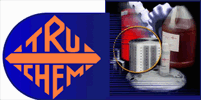

|
T.C. 29 |
||||||
|
||||||
 |
 |
|
| MISSION STATEMENT | HOME |
|
|
INTRODUCTION T.C. 29 is a very unique liquid inhibitor designed specifically for use in industrial cleaning operations to prevent acid attack on mild steel, stainless steel and copper or brass. It is an effective inhibitor for phosphoric, sulfuric, hydrochloric, acetic, citric, oxalic, sulfamic, tartaric and sodium bisulfate acids. It can be added to the above acids for the protection of equipment during chemical cleaning operations and descaling operations, such as:
T.C. 29 consists of ingredients that are listed in the Code of Federal Regulation, Title 40 (Protection of Environment) under these sections: Section 178 (Emulsifiers and/or Surface Active Agents), Section 180 (Tolerance and exemptions from tolerances for pesticide chemicals in or on raw agriculture commodities) and Title 21, Section 170 (Food Additives). Sections 182 and 582 (Substance Generally Recognized as Safe), Section 184 (Direct Food Substances Affirmed as GRAS), Section 172 (Food Additives Permitted for Direct Additions to Food for Human Consumption). CONCENTRATION T.C. 29 is used at a concentration of 2 gallons of inhibitor per 1000 gallons of diluted acid solution. USAGE T.C. 29 may be added to either the diluted or the concentrated hydrochloric acid. For all other acids, T.C. 29 must be added to the diluted acid solution. The diluted acid, inhibited with T.C. 29, is best circulated through the equipment to be cleaned. When circulation cannot be accomplished, the equipment should be filled with the inhibited acid and sufficient time allowed for the acid to remove the objectionable deposits. If heating of acid or equipment is desired to speed up the operation, it should be done prior to the cleaning. Note: T.C. 29 is soluble in concentrated 20° Be' hydrochloric acid. A change in appearance from a clear, light orange solution to a hazy, dark orange solution will occur with time of T.C. 29 in concentrated 20° Be' HCI without a loss in inhibitor performance. The maximum protection afforded by T.C. 29 is dependent on the specific acid being used, the composition of the metal surface and the temperature of the cleaning bath. The following table lists the maximum cleaning bath temperature allowed for each metal and specific acid:
* The information used to prepare this table was based on testing the following acid compositions:
STORAGE REQUIREMENTS T.C. 29 will freeze at 23°F. Freezing is detrimental to the product. It is recommended that the product be stored indoors where the temperature will not go lower than 32°F. DISPOSAL Applicable regulations concerning disposal and discharge of chemicals should be consulted and followed. Disposal information for T.C. 29 is given on the Material Safety Data Sheet. The industrial cleaning bath is acidic and contains organic RODINE inhibitor components. The industrial cleaning bath and sludge can contain ingredients other than those in the chemical as supplied and analysis of the solution and/or sludge is required before waste treatment and disposal. PRECAUTIONARY INFORMATION Before handling the chemical products used in the process, the first aid and handling recommendations on the Material Safety Data Sheet for T.C. 29 should be read, understood and followed. |